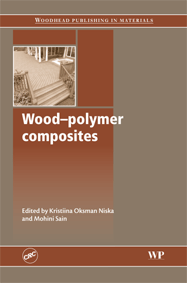 The new specialised book on Wood-polymer Composites (WPC) provides a comprehensive survey of major new developments. It reviews the key aspects of manufacturing, including raw materials and manufacturing technologies, and discusses properties such as durability, creep behaviour and processing performance.
The new specialised book on Wood-polymer Composites (WPC) provides a comprehensive survey of major new developments. It reviews the key aspects of manufacturing, including raw materials and manufacturing technologies, and discusses properties such as durability, creep behaviour and processing performance.
The volume contains a collection with articles from at least 25 international experts. It concludes by looking at ways of assessing performance and at the range of current and future applications. Chapter 14 (“Markets and future trends of wood-polymer composites in Europe”) is authored by the nova-Institut, Hürth and Dr. Korte (www.hanskorte.de).
In conclusion, this book might become the definitive publication for anyone using and studying these new biomaterials.
Definition
Wood-polymer composites (abbr.: WPC; sometimes named wood-plastics) are materials in which wood is impregnated with monomers that are then polymerised in the wood to tailor the material for special applications. The resulting properties of these materials, from lightness and enhanced mechanical properties to greater sustainability, has meant a growing number of applications in such areas as building, construction and automotive engineering.
Editors
Professor Kristiina Oksman Niska works in the Division of Manufacturing and Design of Wood and Bionanocomposites, Luleå University of Technology, Sweden, Professor Mohini Sain works in the Faculty of Forestry, University of Toronto, Canada. Both are internationally-known for their research on wood-polymer composites. An international team of experts has contributed content tothe book.
Contents
- Introduction
K Oksman Niska Luleå University of Technology, Sweden and M Sain University of Toronto, Canada - Raw materials for wood-polymer composites
C Clemons, USDA Forest Service, USA
– Introduction
– Polymers: structure and properties
– Wood: structure and properties
– References and further reading - Additives for wood-polymer composites
D V Satov, Canada Colors and Chemicals Limited, Canada
– Introduction
– Lubricants and rheology control additives for thermoplastic composites
– Coupling agents
– Stabilizers
– Fillers
– Density reduction additives
– Biocides
– Product aesthetics additives
– Flame retardants and smoke suppressants
– Future trends
– Conclusions - Interactions between wood and synthetic polymers
K Oksman Niska and A Sanadi, Luleå University of Technology, Sweden
– Introduction
– The interface and interphase in composites
– Wetting, adhesion and dispersion
– Techniques to evaluate interfacial interactions and adhesion
– Improving interface interactions in wood-polymer composites
– Interphase effects on other properties
– Conclusions
– References and further reading - Manufacturing technologies for wood-polymer composites
D Schwendemann, Coperion Werner & Pfleiderer GmbH & Co. KG, Germany
– Introduction
– Raw material handling
– Compounding technologies
– Pelletizing systems
– Profile extrusion
– Injection moulding
– Sheet extrusion
– Future trends
– References - Mechanical properties of wood-polymer composites
M Sain and M Pervaiz, University of Toronto, Canada
– Introduction
– Mechanical performance of wood-polymer composites
– General mechanical properties of wood-polymer composites and test methods
– Critical parameters affecting mechanical properties of wood-polymer composites
– Conclusions
– References - Micromechanical modelling of wood-polymer composites
R C Neagu, Ecole Polytechnique Fédérale de Lausanne (EPFL), Switzerland and E K Gamstedt, Kungliga Tekniska Högskolan (KTH), Sweden
– Introduction
– Elastic properties
– Hygroexpansion
– Strength
– Conclusions
– References - Outdoor durability of wood-polymer composites
N Stark, USDA Forest Service and D Gardner, University of Maine, USA
– Introduction
– Characteristics of raw materials
– Changes in composite properties with exposure
– Methods for protection
– Future trends
– Sources of further information and advice
– References and further reading - Creep behaviour and damage of wood-polymer composites
N Marcovich and M I Aranguren, Universidad Nacional de Mar del Plata, Argentina
– Introduction
– Viscoelasticity and creep
– Creep in wood-plastic composites
– Creep failure and material damage
– Conclusions and future trends
– References - Processing performance of extruded wood-polymer composites
K Englund with M Wolcott, Washington State University, USA
– Introduction
– Current extrusion processing methods for natural fiber thermoplastic composites
– Rheology of a wood fiber-filled thermoplastic
– Commercial wood-polymer composites
– References - Oriented wood-polymer composites and related materials
F W Maine, Frank Maine Consulting Ltd, Canada
– Introduction
– Orientation of polymers
– Applications
– Current developments
– Future trends
– References - Wood-polymer composite foams
G Guo, University of Southern California, USA, G Rizvi, University of Ontario Institute of Technology and C B Park, University of Toronto, Canada
– Introduction
– Structure and characterization of wood-polymer composite foams
– Critical issues in production of wood-polymer composite foams
– Fundamental mechanisms in blowing agent-based foaming of wood-polymer composites
– Foaming of wood-polymer composites with chemical blowing agents
– Foaming of wood-polymer composites with physical blowing agents
– Foaming of wood-polymer composites with heat expandable microspheres
– Void formation in wood-polymer composites using stretching technology
– Effects of additives on wood-polymer composite foams
– Summary and future trends
– References - Performance measurement and construction applications of wood-polymer composites
R J Tichy, Washington State University, USA
– Introduction
– Performance measures and building codes
– Wood-polymer composite properties
– Building construction applications
– Conclusions
– References - Life cycle assessment (LCA) of wood-polymer composites: a case-study
T Thamae and C Baillie, Queens University, Canada
– Introduction: comparing wood-polymer and glass-fibre reinforced polypropylene car door panels
– The life cycle assessment process
– Goal and scope definition
– Inventory
– Impact assessment
– Interpretation
– The possible effect of European Union legislation on end-of-life vehicles
– Conclusions
– Acknowledgements
– References - Market and future trends for wood-polymer composites in Europe: the example of Germany
M Carus and C Gahle, nova-Institut and H Korte, Innovationsberatung Holz & Fasern, Germany
– Introduction
– The development of the European market: the example of Germany
– The most significant wood-polymer composite products in the European market
– Future trends: markets
– Future trends: processing and materials
– Conclusions
– Wood-polymer composite codes, standards, research and manufacturing in Europe
– The nova-Institut and Innovationsberatung Holz und Fasern
– Examples of wood polymer-composite products
– References - Improving wood-polymer composite products: a case study
A Klyosov, MIR International Inc., USA
– Introduction: wood-polymer composite decking
– Brands and manufacturers
– Improving the performance of wood-polymer composite decking
– Conclusions
– References
Product Details
Hardcover: 366 pages
Publisher: CRC (June 24, 2008)
Language: English
ISBN-10: 1420076116
ISBN-13: 978-1420076110
Pricing: £135.00 / US$270.00 / €200.00 (estimated)
Further information, contact and ordering
- Product Website: Wood-polymer Composites
- Order online
- Order by fax: Print an Order form and Fax to +353 1 4100 980
- Order by mail: Print an Order form and post to Research and Markets Ltd. Guinness Center, Taylors Lane, Dublin 8. Ireland.
- Order at your local bookstore.
Source
Woodhead Publishing Limited, 2008-07-21.
Supplier
Dr. Hans Korte - Innovationsberatung Holz & Fasern
Luleå University of Technology
nova-Institut GmbH
University of Toronto, Kanada
Share
Renewable Carbon News – Daily Newsletter
Subscribe to our daily email newsletter – the world's leading newsletter on renewable materials and chemicals









